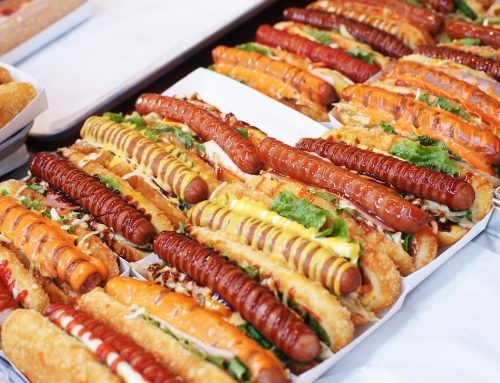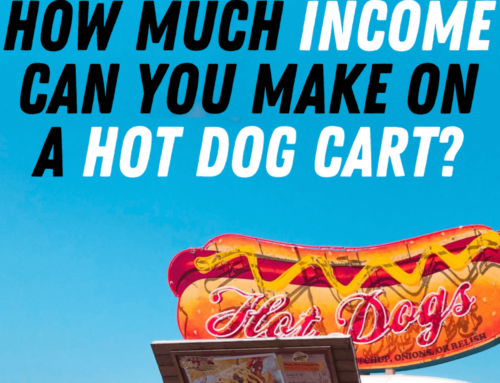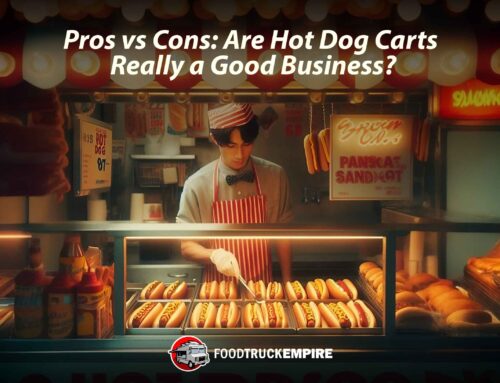Podcast: Play in new window | Download | Embed
Subscribe: RSS
It’s a fact: The hot dog stand business model is one of the lowest cost and simplest businesses you could start. If you’ve been researching the topic online, you’ve probably seen claims that you could get started for less than $1,000 and be operating a profitable business right away. But are those claims of fast profit legit?
For this post, I spoke with a 5+ year hot dog veteran Matt Gladfelter from Bow Ties and Hot Dogs about how much it really costs to start and operate this business. On the low-end, you could start a hot dog cart for as low as $4,500 if you can get a used cart, all the way up to $28,900 if you want to go all out. Take a look at the spreadsheet below for all the fixed and variable costs of opening a hot dog cart.
Hot Dog Cart Startup Costs Spreadsheet

| Equipment | Estimated Cost | Notes |
|---|---|---|
| Hot Dog Cart + Cooking Equipment | $3,000 – $20,000 | A hot dog cart will typically cost a few thousand dollars. A larger hot dog trailer that a couple employees can cook in will cost more. |
| Initial Product Inventory | $300 – $1,000 | This will include Hot Dogs, Buns, and any Condiments. |
| Permits and Licenses | $100 – $500 | Varies a lot depending on where you operate. |
| Website | Free – $2,000 | You may not even need one of these. A Facebook page can serve as a simple alternative. |
| Facebook / Twitter | Free | |
| Cash Register / POS | $200 – $1,000 | Can also use an iPad and an app for credit transactions. |
| Uniforms / T-Shirts | $0 – $1,000 | |
| Paper Products (Plates / Napkins, etc.) | $200 – $300 | |
| Misc. Expenses | $500 – $2,000 | Plan for some unexpected expenses here and put it into the budget. |
| Smallwares: Tongs, Spatulas, Spoons, etc. | $100 – $500 | |
| Fire Extinguisher | $100 – $300 | For safety! |
| Kitchen or Storage Space Rental | Varies | If you don’t have space at home, you might need to rent a kitchen or storage space for prepping and storing supplies. |
| Marketing and Advertising Costs | Varies | Initial costs for marketing materials like flyers, business cards, or online ads. |
| Signage and Branding | Varies | Costs for professional signage on your cart and branding materials. |
| Total Low End | $4,500 | |
| Total High End | $28,600 |
Hot Dog Cart Monthly Costs
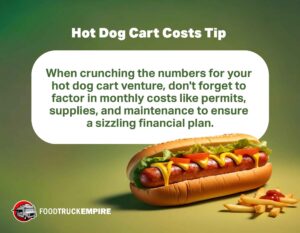
A tip to consider.
| Item | Monthly Estimated Cost | Notes |
|---|---|---|
| Commissary | $0 | This is a highly variable cost. |
| Phone / Internet | $50 – $200 | |
| Fuel | $0 – $300 | This will vary greatly depending on gas prices and how far you plan to travel to vend. |
| Labor | ??? | $10 – $15 per hour is average rate. Or if you plan to operate the cart yourself there is no cost here. |
| Repairs / Upgrades | $100 | Bad things happen sometimes. Best to be prepared for the unexpected. |
| Food / Beverage Restock | $500 – $2,000 | Depends on food cost and frequency of operation. Higher restocking isn’t a bad thing. Might just mean you’re selling lots of hot dogs each month. |
| Paper Product Restock | $200 – $500 | Depends on food cost and frequency of operation. Higher restocking isn’t a bad thing. Might just mean you’re selling lots of hot dogs each month. |
| Insurance | $25 – $100 | Can remove insurance in winter if you don’t plan to operate. |
| Propane | $20 – $40 | At the time of writing, propane is cheap and you can refill a standard size tank for around $20. |
| Utilities for Storage or Prep Space | Varies | If you rent a space for storage or food prep, there might be utility costs involved. |
| Total Low End | $885 | |
| Total High-End End | $3,210 |
Note: If you would like to copy and paste this into a spreadsheet to enter your own information, you can find the template here: Cost Spreadsheet.
Some additional thoughts about recurring monthly expenses… I wouldn’t consider a higher monthly expense to be a bad thing with this business model. If you have to buy more hot dog buns, sausages, and other supplies, it means you’re probably selling more hot dogs too! Ditto for the gas and propane costs. If this is higher, it probably means you’re traveling to a lot of events and making a profit.
One other thing you’ll need to remember when it comes to monthly expenses is that you’ll have to pay taxes on all revenue generated through the food cart. Like all businesses, you need to pay the IRS.
Another variable item not factored into the spreadsheet above is the cost of vending at certain locations. Although Matt Gladfelter who is featured in the interview rarely needs to pay to vend at locations. However, paying for a location is an option, especially if you would like to be in a consistent location. If you’re interested in paying for a more consistent location Street Eats by Best Vendors is a great place to start the search no matter where you live in the United States.
One other big advantage to this specific type of business versus other mobile food models is that you don’t have much in terms of food waste. According to the USDA.gov website, you can preserve hot dogs in the freezer safely for 1 – 2 years. Of course, once you thaw those out you’ll need to use them in the next week or two to ensure the best taste and quality possible for customers.
One point that Gladfelter makes during the discussion is extremely insightful. When starting out there are three costs:
- Paper Cost – This is what you expect to pay to start and operate a hot dog business. The paper cost is outlined in the spreadsheet below.
- Ideal Cost – This is the amount you would expect to invest in a perfect world. The ideal cost is something that you will need to tweak and work toward within your business. For example, one way to cut costs would be to reduce food waste. As a business owner, you should be able to reduce cost overtime as you begin to understand how much food you’ll need to purchase for each event.
- Realistic Cost – Life happens. Things break. Hot dogs are accidentally dropped to the curb. Expenses come up that you didn’t realize would be important. It’s important to build in a bit of a buffer with your expected monthly costs of operation.
Variable Factors that Determine Startup Cost
When evaluating the hot dog business, there are multiple costs you need to keep in mind that are dependent on the rules and health codes where you live.
Investing in the Right Cart – Before you invest in a hot dog cart, you need to understand the local health requirements to vend legally in your city. The last thing you want to do is spend a couple thousand dollars on a cart that you won’t ever be able to use because it doesn’t meet health requirements, like no available hot / cold water source.
Typically, you will be able to find this information by contacting the city hall and asking about their requirements for food vendors. As you can see, the cheap cart you’re able to find for sale on Craigslist might not be the great deal it is advertised as if you can’t use it.
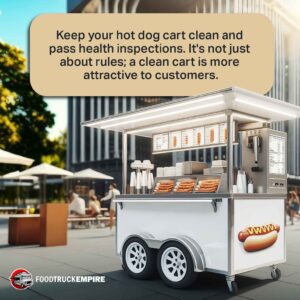
Keep your hot dog cart clean.
As a hot dog vendor, your health requirements will often be lower than someone that wanted to start a burger stand, where they would need to actually cook meat. Still, you want to make sure that you’re passing any health inspection with flying colors. Not just for government regulations, but it will make your cart more appealing to prospective customers too.
Easily for under $7,000 you should be able to get started. – Matt Gladfelter on the average cost of getting started in this business.
Local Permits – While you’re at city hall, be sure to ask about any permits you’ll need to acquire to vend within city limits. As a general rule of thumb if you live in a big city like New York, you’ll pay a lot to get started. If you live in a smaller city, there are generally lower permits. Often these permits need to be renewed on a yearly basis so you’ll need to build these into your expenses. According to a real-life example from John Caruthers over at SeriousEats.com, at the time of writing in the city of Chicago it will cost $700 for a two-year license. In addition, you’ll also need to budget $100 for a fire safety permit.
Fortunately, once you’ve done the research within your particular city the costs to operate this type of business is pretty straight forward and consistent no matter where you’re located. A hot dog bun, Vienna sausage, and a mustard packet are about the same no matter where you’re located.
Ways to Save Money Starting a Hot Dog Cart
Naturally, everyone wants to save money on their hot dog startup. But sometimes, trying too hard to save money can cost you as Gladfelter explained in our discussion. One of the biggest mistakes you can make in terms of starting a hot dog cart is buying a cheap hot dog cart that won’t pass health inspections in your area. As Gladfelter shares in the podcast, “Don’t impulse buy because you see a cart for $1,000 on Craigslist. If it doesn’t pass health codes it’s useless.”

Maximize profits, minimize waste.
Buy a Used Hot Dog Cart: Instead of buying new, look for a used hot dog cart in good condition. This can significantly reduce your initial investment. Check online marketplaces on Facebook or Craigslist, restaurant closing sales, or local classified ads. Matt bought his first hot dog cart from a restaurant owner for only $2,500 so this is a legit option as long as it meets or exceeds local health requirements.
Limit Your Menu Initially: Start with a basic menu. Offering a limited range of items reduces inventory costs and waste. As your business grows, you can gradually expand your menu. “When I started out, I had a lot of things on my menu that I don’t now.” says Gladfelter. “That’s one thing that I would recommend… Going with the basics at first.”
Related Reading: How Much Income Can a Hot Dog Cart Make? My Experience.
Bulk Purchases for Inventory: Buy your supplies in bulk where possible. Items like hot dogs, buns, and condiments can be cheaper when purchased in larger quantities.
Reduce Food Waste – If you find yourself throwing away buns, sausages, or anything else, you throw away is lost money. Fortunately, the food waste for a hot dog cart is lower than typical than restaurants because the food you make has a long shelf life of weeks or month.
Condiments like ketchup and mustard, you don’t need to worry about spoilage as long as they are stored at room temperature. The main items you’ll need to be concerned about is your hot dog buns won’t taste as fresh after a few days. There are also certain premium items like grilled onions or bacon that you can only serve one day.
Still, low food waste is a huge advantage over other food business models. Every food business will have a certain level of waste. But, due to the long life of the product, you will be able to maximize your profits.
Quotes from the Show
What I used the part-time for was proving the business plan and really taking that as the opportunity to make sure my costs were correct and my cooking procedures were what I wanted. – Matt Gladfelter on why he started his business on the side, before transitioning for full-time business owner.
We started out with like $2,500. That was the first egg to put this business together. – Matt Gladfelter on his initial investment.
One event on a weekend and you’ll have that investment back to be honest. – Matt Gladfelter on how long it took to recoup his initial investment in a used cart.

Want to start your own hot dog business venture?


